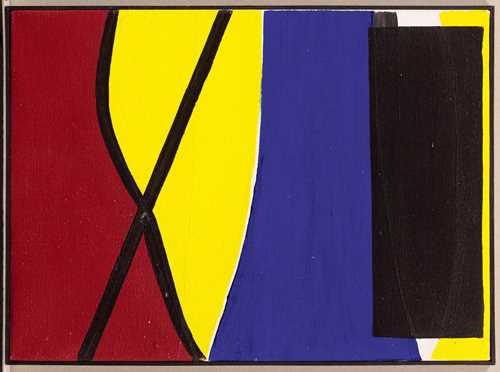
拍品 3438* - A197 战后和当代 - Donnerstag, 01. Juli 2021, 05.00 PM
ROY LICHTENSTEIN
(1923 New York City 1997)
Untitled. 1979.
Oil on canvas.
Signed, dedicated, as well as with location and date on the reverse: for Nana & Novarro with love. Southhampton 1979. Roy L.
31.5 × 42.5 cm.
This work will be included in the forthcoming catalogue raisonné by the Roy Lichtenstein Foundation.
Provenance:
- Nana und Eddy Novarro collection.
- Dr. Gerhard Cromme.
- Formerly private collection Germany.
Exhibitions:
- Münster 2011, Who is Who: Eddy Novarro und die Avantgarde der 50er bis 70er Jahre. Picasso Museum, 9 July - 9 October, No. 62, p. 146/147 (colour illus.).
- Schwerin 2015, Kaleidoskop der Moderne: Chagall, Miró, Picasso und die Avantgarde. Staatliches Museum, 10 July - 18 October, p. 172 (colour illus.).
The colours yellow, red, blue and black, like a constant motif, literally permeate Roy Lichtenstein's œuvre. The Pop Art artist achieved his breakthrough in the 1960s primarily through his colourful, sumptuous prints strewn with benday dots. Developed by Ben Day, the printing technique was used in the 50s and 60s mainly in the comic industry to produce shades and secondary colours (e.g. green, purple, orange, flesh tones) at low cost using dots printed in primary colours (cyan, magenta, yellow, black). Depending on the desired effect, colour, or optical illusion, small coloured dots are arranged at different distances or overlapping. Lichtenstein used this stylistic device like no other; it became his personal trademark and can be found in almost all his works.
This painting, however, given its technique, does not have much in common with those instantly recognisable compositions. It was painted in Southampton in 1979 and counts as one of the artist's late works. Ten years earlier, Lichtenstein had bought a property with a studio outside New York, where he worked in relative seclusion. With a two–dimensional, impasto style in the four primary colours on a comparably small canvas (31.5 × 42.5 cm), he created an altogether singular geometric abstraction as a counterpart to works such as "Crying Girl" or "Nurse", which with their use of dots and stripes are absolutely captivating.
On the reverse is a dedication by the artist to the photographer Eddy Novarro and his wife Renate, called Nana. Novarro photographed countless prominent painters from 1950–70, including Picasso, Miró, Giacometti, Chagall, Rothko and Fontana. As a token of gratitude for his intimate portraits of the artists, he received drawings and fleeting sketches, but also paintings and objects. In this way, a unique collection was formed, ranging from Classical Modernism to Abstract Expressionism and Pop Art. Coming from this extraordinary collection and with its distinctive technique, this work has a special significance within Lichtenstein's œuvre as a whole.
Provenance:
- Nana und Eddy Novarro collection.
- Dr. Gerhard Cromme.
- Formerly private collection Germany.
Exhibitions:
- Münster 2011, Who is Who: Eddy Novarro und die Avantgarde der 50er bis 70er Jahre. Picasso Museum, 9 July - 9 October, No. 62, p. 146/147 (colour illus.).
- Schwerin 2015, Kaleidoskop der Moderne: Chagall, Miró, Picasso und die Avantgarde. Staatliches Museum, 10 July - 18 October, p. 172 (colour illus.).
The colours yellow, red, blue and black, like a constant motif, literally permeate Roy Lichtenstein's œuvre. The Pop Art artist achieved his breakthrough in the 1960s primarily through his colourful, sumptuous prints strewn with benday dots. Developed by Ben Day, the printing technique was used in the 50s and 60s mainly in the comic industry to produce shades and secondary colours (e.g. green, purple, orange, flesh tones) at low cost using dots printed in primary colours (cyan, magenta, yellow, black). Depending on the desired effect, colour, or optical illusion, small coloured dots are arranged at different distances or overlapping. Lichtenstein used this stylistic device like no other; it became his personal trademark and can be found in almost all his works.
This painting, however, given its technique, does not have much in common with those instantly recognisable compositions. It was painted in Southampton in 1979 and counts as one of the artist's late works. Ten years earlier, Lichtenstein had bought a property with a studio outside New York, where he worked in relative seclusion. With a two–dimensional, impasto style in the four primary colours on a comparably small canvas (31.5 × 42.5 cm), he created an altogether singular geometric abstraction as a counterpart to works such as "Crying Girl" or "Nurse", which with their use of dots and stripes are absolutely captivating.
On the reverse is a dedication by the artist to the photographer Eddy Novarro and his wife Renate, called Nana. Novarro photographed countless prominent painters from 1950–70, including Picasso, Miró, Giacometti, Chagall, Rothko and Fontana. As a token of gratitude for his intimate portraits of the artists, he received drawings and fleeting sketches, but also paintings and objects. In this way, a unique collection was formed, ranging from Classical Modernism to Abstract Expressionism and Pop Art. Coming from this extraordinary collection and with its distinctive technique, this work has a special significance within Lichtenstein's œuvre as a whole.
CHF 80 000 / 120 000 | (€ 82 470 / 123 710)
以瑞士法郎銷售 CHF 134 500 (包含買家佣金)
所有信息随时可能更改。

